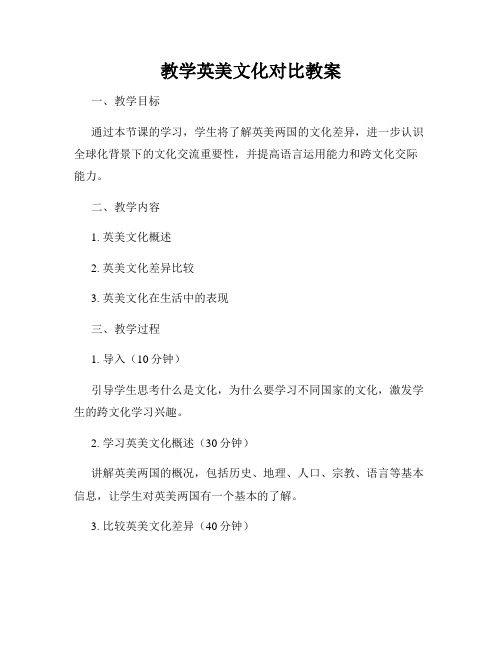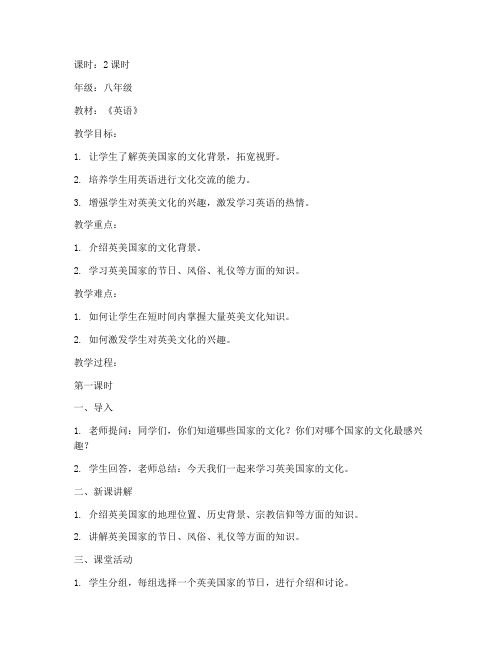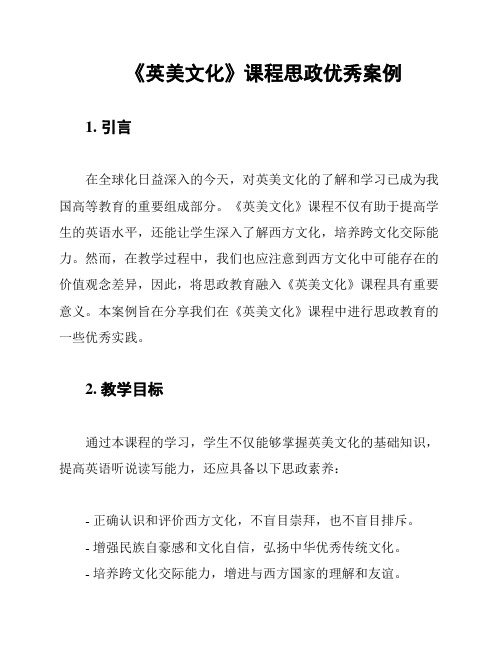英美文化教案
教学英美文化对比教案

教学英美文化对比教案一、教学目标通过本节课的学习,学生将了解英美两国的文化差异,进一步认识全球化背景下的文化交流重要性,并提高语言运用能力和跨文化交际能力。
二、教学内容1. 英美文化概述2. 英美文化差异比较3. 英美文化在生活中的表现三、教学过程1. 导入(10分钟)引导学生思考什么是文化,为什么要学习不同国家的文化,激发学生的跨文化学习兴趣。
2. 学习英美文化概述(30分钟)讲解英美两国的概况,包括历史、地理、人口、宗教、语言等基本信息,让学生对英美两国有一个基本的了解。
3. 比较英美文化差异(40分钟)通过图表数据、图片、视频等多种教学手段,比较英美两国在礼仪、饮食、文艺、教育、商务等方面的不同点,让学生真切感受到不同文化在实际应用中的差异。
4. 探究英美文化在生活中的表现(30分钟)分组讨论英美文化差异对生活的影响,例如英美两国在节日庆典、家庭结构、社交交际、身体语言等方面的不同表现。
然后组织学生进行展示和交流,以加深对英美文化的理解。
5. 总结(10分钟)对本节课所学内容进行总结,引导学生思考文化差异的重要性,并帮助学生通过反思,找到自己在跨文化交流中存在的可能问题。
四、课后作业1. 用英语写一篇短文,介绍中美两国在饮食文化方面的差异(200字)。
2. 观看一部关于英国霍格沃兹学院的电影,简单介绍电影中出现的英国文化元素(100字)。
五、教学反思本节课采用了多样化的教学手段,如图表数据、图片、视频、小组讨论等多种形式,让学生能够更直观、全面地感受到英美两国文化的不同之处。
同时,通过课后作业的设置,也提高了学生的学习主动性和语言表达能力。
但是,本节课时间紧凑,对部分内容进行了简化,有待进一步拓展和深化。
英美文化 英语 教案初中

英美文化英语教案初中Introduction:In this English lesson plan for middle school students, we will explore the cultural aspects of both the United Kingdom and the United States. By learning about the similarities and differences between British and American culture, students will not only improve their English language skills but also gain a deeper understanding of these two influential countries.Lesson Objectives:Understand the key cultural aspects of the United Kingdom and the United States.Compare and contrast British and American culture.Improve English language skills through vocabulary and speaking exercises.Warm-up Activity:To engage students and introduce the topic, begin with a warm-up activity. Divide the class into pairs or small groups and ask them to brainstorm words or phrases that they associate with the United Kingdom and the United States. Encourage students to think about famous landmarks, food, music, and customs. After a few minutes, have each group share their ideas with the class.Main Activity 1: Cultural Similarities and Differences。
英美文化扩展教案模板范文

课时:2课时年级:八年级教材:《英语》教学目标:1. 让学生了解英美国家的文化背景,拓宽视野。
2. 培养学生用英语进行文化交流的能力。
3. 增强学生对英美文化的兴趣,激发学习英语的热情。
教学重点:1. 介绍英美国家的文化背景。
2. 学习英美国家的节日、风俗、礼仪等方面的知识。
教学难点:1. 如何让学生在短时间内掌握大量英美文化知识。
2. 如何激发学生对英美文化的兴趣。
教学过程:第一课时一、导入1. 老师提问:同学们,你们知道哪些国家的文化?你们对哪个国家的文化最感兴趣?2. 学生回答,老师总结:今天我们一起来学习英美国家的文化。
二、新课讲解1. 介绍英美国家的地理位置、历史背景、宗教信仰等方面的知识。
2. 讲解英美国家的节日、风俗、礼仪等方面的知识。
三、课堂活动1. 学生分组,每组选择一个英美国家的节日,进行介绍和讨论。
2. 每组选派一名代表,向全班同学介绍所选国家的节日。
四、课堂小结1. 老师总结本节课所学内容,强调英美国家的文化特点。
2. 学生分享自己对本节课的收获。
第二课时一、复习导入1. 老师提问:上节课我们学习了哪些英美国家的文化知识?2. 学生回答,老师总结:今天我们将继续学习英美国家的文化。
二、新课讲解1. 介绍英美国家的饮食文化、教育制度、艺术等方面的知识。
2. 讲解英美国家的影视作品、音乐、舞蹈等方面的特点。
三、课堂活动1. 学生分组,每组选择一个英美国家的艺术形式,进行介绍和讨论。
2. 每组选派一名代表,向全班同学介绍所选国家的艺术形式。
四、课堂小结1. 老师总结本节课所学内容,强调英美国家的艺术特点。
2. 学生分享自己对本节课的收获。
教学评价:1. 学生对英美国家文化的了解程度。
2. 学生在课堂活动中的表现。
3. 学生对英语学习的兴趣和热情。
教学反思:1. 本节课是否达到了教学目标?2. 学生是否对英美文化产生了兴趣?3. 教学过程中是否遇到了困难,如何解决?板书设计:一、英美国家文化背景1. 地理位置和历史背景2. 宗教信仰3. 节日、风俗、礼仪二、英美国家文化特点1. 饮食文化2. 教育制度3. 艺术特点三、英美国家艺术形式1. 影视作品2. 音乐3. 舞蹈。
英美文化教学教案模板范文

课时:2课时年级:八年级教材:《英语》八年级上册教学目标:1. 知识目标:了解英美国家的文化背景、风俗习惯、历史传统等,提高学生对英美文化的认识。
2. 能力目标:通过小组讨论、角色扮演等方式,培养学生的英语口语表达能力,提高学生运用英语进行跨文化交流的能力。
3. 情感目标:激发学生对英美文化的兴趣,培养学生尊重和理解不同文化的态度。
教学重点:1. 英美国家的文化背景和历史传统。
2. 英美国家的风俗习惯和节日庆典。
教学难点:1. 如何将文化知识融入英语教学中。
2. 如何引导学生进行跨文化交流。
教学准备:1. 教学课件或相关图片、视频资料。
2. 英美文化相关书籍或资料。
3. 学生分组讨论所需道具。
教学过程:第一课时一、导入1. 教师简要介绍英美文化的重要性,引导学生关注并了解不同国家的文化。
2. 播放一段关于英美国家的风光视频,激发学生对英美文化的兴趣。
二、新课导入1. 教师讲解英美国家的地理位置、历史背景、政治制度等基本知识。
2. 学生通过阅读教材,了解英美国家的文化特点。
三、小组讨论1. 将学生分成若干小组,每组讨论以下问题:a. 英美国家的节日有哪些?这些节日有何特点?b. 英美国家的饮食文化有何特点?c. 英美国家的教育体系有何特点?2. 各小组派代表分享讨论成果,教师点评并总结。
四、角色扮演1. 教师提供一段关于英美国家日常生活的对话情景,让学生分组进行角色扮演。
2. 角色扮演结束后,教师点评并指导学生如何运用所学知识进行跨文化交流。
第二课时一、复习1. 教师带领学生回顾上节课所学的英美文化知识。
2. 学生通过提问、回答等方式巩固所学知识。
二、拓展1. 教师讲解英美国家的传统艺术、建筑、音乐等文化特色。
2. 学生通过阅读教材、查阅资料等方式,进一步了解英美文化。
三、课堂小结1. 教师总结本节课所学的英美文化知识。
2. 学生分享自己对英美文化的认识和感悟。
四、作业布置1. 让学生收集关于英美国家的图片、视频等资料,下节课进行展示。
英美国家习俗文化校本教案

英美国家习俗文化校本教案第一章:英美国家的节日习俗教学目标:1. 了解英美国家的常见节日,如圣诞节、感恩节、万圣节等。
2. 学习节日习俗和庆祝方式,如装饰圣诞树、交换礼物、吃火鸡等。
3. 培养学生的跨文化交际意识,尊重和理解不同国家的节日习俗。
教学内容:1. 介绍英美国家的常见节日及其日期和由来。
2. 讲解节日习俗和庆祝方式,如圣诞节的装饰和交换礼物,感恩节的火鸡餐等。
3. 通过案例分析和小组讨论,让学生了解和体验不同节日的文化内涵。
教学活动:1. 引导学生收集有关英美节日习俗的信息,进行小组分享。
2. 组织学生进行角色扮演,模拟在英美国家庆祝节日的场景。
第二章:英美国家的饮食文化教学目标:1. 了解英美国家的传统美食和饮食习惯。
2. 学习英美国家的饮食礼仪和餐桌规则。
3. 培养学生的饮食文化意识和健康饮食习惯。
教学内容:1. 介绍英美国家的传统美食,如英国的炸鱼薯条、美国的感恩节火鸡等。
2. 讲解英美国家的饮食礼仪和餐桌规则,如使用刀叉的顺序、不发出声音等。
3. 通过品尝和制作美食的活动,让学生体验英美国家的饮食文化。
教学活动:1. 组织学生进行小组讨论,分享对英美国家美食的了解和体验。
2. 邀请专业厨师进行讲解和演示,让学生学习英美国家的饮食礼仪和餐桌规则。
3. 开展美食制作活动,让学生亲手制作英美国家的传统美食。
第三章:英美国家的社交礼仪教学目标:1. 了解英美国家的基本社交礼仪,如问候、介绍、道别等。
2. 学习英美国家的商务礼仪和电子邮件写作规范。
教学内容:1. 介绍英美国家的基本社交礼仪,如问候时的握手、介绍时的姓名和职位等。
2. 讲解英美国家的商务礼仪和电子邮件写作规范,如正式商务场合的着装要求、电子邮件的格式和用语等。
3. 通过角色扮演和模拟场景,让学生实践和应用所学的社交礼仪。
教学活动:1. 组织学生进行小组讨论,分享对英美国家社交礼仪的了解和体验。
2. 邀请专业讲师进行讲解和示范,让学生学习英美国家的商务礼仪和电子邮件写作规范。
《英美文化》课程思政优秀案例

《英美文化》课程思政优秀案例1. 引言在全球化日益深入的今天,对英美文化的了解和学习已成为我国高等教育的重要组成部分。
《英美文化》课程不仅有助于提高学生的英语水平,还能让学生深入了解西方文化,培养跨文化交际能力。
然而,在教学过程中,我们也应注意到西方文化中可能存在的价值观念差异,因此,将思政教育融入《英美文化》课程具有重要意义。
本案例旨在分享我们在《英美文化》课程中进行思政教育的一些优秀实践。
2. 教学目标通过本课程的学习,学生不仅能够掌握英美文化的基础知识,提高英语听说读写能力,还应具备以下思政素养:- 正确认识和评价西方文化,不盲目崇拜,也不盲目排斥。
- 增强民族自豪感和文化自信,弘扬中华优秀传统文化。
- 培养跨文化交际能力,增进与西方国家的理解和友谊。
- 树立正确的价值观, resist external interference and ideological infiltration.3. 教学策略为了实现上述教学目标,我们采取了一系列有针对性的教学策略:3.1 导入思政元素在讲解英美文化的同时,教师应适时引入思政教育内容,例如,通过介绍我国与西方国家的文化交流历史,让学生了解我国在文化交流中的地位和作用,增强民族自豪感。
3.2 对比分析教师可以引导学生对英美文化中的价值观念进行对比分析,例如,在讲解美国“自由主义”价值观时,可与之我国的社会主义核心价值观进行对比,让学生了解两种文化的差异,并引导学生树立正确的价值观。
3.3 案例讨论教师可选择一些具有代表性的英美文化案例,让学生进行讨论,例如,讨论西方国家的种族歧视、贫富差距等问题,引导学生从多元视角看待问题,提高其批判性思维能力。
3.4 小组合作教师可组织学生进行小组合作,完成一些与英美文化相关的课题,例如,制作关于英美文化的宣传册、举办英美文化讲座等,让学生在实践中提高跨文化交际能力。
4. 教学效果通过以上教学策略,我们在《英美文化》课程中取得了显著的思政教育成果:- 学生对西方文化的认识更加全面、客观,能够正确评价和借鉴西方文化。
英美社会与文化教案
英美社会与文化教案教案标题:探索英美社会与文化教学目标:1. 了解英美社会与文化的历史和发展2. 探讨英美社会与文化的特点和差异3. 分析英美社会与文化对世界的影响教学重点:1. 英美社会与文化的历史和发展2. 英美社会与文化的特点和差异3. 英美社会与文化对世界的影响教学内容及安排:1. 第一课时:英美社会与文化的概述- 介绍英美社会与文化的概念和范围- 分析英美社会与文化的历史渊源- 讨论英美社会与文化在全球化背景下的地位和影响2. 第二课时:英美社会与文化的特点和差异- 比较英美社会与文化的特点和差异,如语言、宗教、风俗习惯等 - 探讨英美社会与文化的多元性和包容性- 分析英美社会与文化对个体和群体的影响3. 第三课时:英美社会与文化对世界的影响- 分析英美社会与文化对世界政治、经济、文化等方面的影响- 探讨英美社会与文化在国际关系中的地位和作用- 思考如何更好地理解和尊重英美社会与文化,促进跨文化交流与合作教学方法:1. 多媒体教学:通过图片、视频等多媒体资料展示英美社会与文化的特点和差异2. 小组讨论:组织学生就英美社会与文化展开讨论,促进思想碰撞和交流3. 角色扮演:让学生扮演英美社会与文化中的代表人物,深入体验和理解其特点和影响4. 实地考察:组织学生进行英美社会与文化的实地考察,深化对其的认识和理解教学评估:1. 课堂表现:学生对英美社会与文化的讨论和参与情况2. 作业完成:学生完成相关阅读、写作和研究任务的质量和深度3. 课堂测试:对学生对英美社会与文化的理解和掌握程度进行测试教学反思:1. 教学内容是否贴近学生生活实际,能否引起学生的兴趣和思考2. 教学方法是否多样化,是否能够激发学生的学习热情和参与度3. 教学评估是否客观全面,是否能够准确反映学生的学习情况和水平通过以上教案的撰写和实施,希望能够引导学生深入了解英美社会与文化,促进跨文化交流与合作,培养学生的国际视野和跨文化交际能力。
英美文化教案
英美⽂化教案Unit OneIntroduction& Unit 1The Society and Culture of Major English-Speaking Countries课程名称:英语国家社会与⽂化本课内容:The Society and Culture of Major English-Speaking Countries授课时间:90分钟教学⽬的:通过本节课的教学,使学⽣了解英语国家社会与⽂化课程的主要内容与要求,了解⽂化的概念;同时对英国有⼀个总体上的了解。
教学意义:帮助学⽣了解主要英语国家的社会与⽂化概貌,如地理、历史、政治、经济、社会⽣活和⽂化传统等⽅⾯的基本知识。
教学重点:⽂化的概念;英国基本情况。
教学难点:英国概况教学⽅式:以电⼦课件为主,辅以少量板书的课堂讲授。
教学内容: (详见下页)1.什么是⽂化?2.英国国⼟与⼈民英国的不同名称及其区域3. 伦敦概况教学⽅法:采取教师教授为主,结合学⽣课堂讨论。
时间分配: What is culture? (10 分钟.);What’s th e relation between Culture and society? (10 分钟);Why should we learn culture (10 分钟);UK- a complicated country with a complicated name(40 分钟)A Brief Idea about London. (20 分钟)课堂板书:1. Culture-the foundation of communication2. The four parts of UK3. Main cities of EnglandLondonBirmingham-second largest city of England.Liverpool-second largest port of EnglandManchester- industrial and commercial centre.课后作业: Exercises in Unit 1Unit OnePart One1.What is culture?Culture-the foundation of communicationCulture is very abstract and complicated. Concretely speaking, it refers to all the aspects of social life, such as, the values, the practices of a society and social conventions, education, politics, art or literature,language,ideas,etc.⽂化即是⼈们所思,所⾔(⾔语和⾮⾔语),所为,所觉的总和.⽂化是⽆处不在的,具体说来,包括社会⽣活的⼀切⽅⾯,如:价值观念,⽣活⾏为⽅式,社会规范等,乃⾄艺术,政治,经济, 教育,修养,⽂学,语⾔,思想等.2. What’s the relation between Culture and society?1)Culture is a separate idea from society, although culture and society are interrelated andcannot exist without each other.2)Culture is a system of values (or beliefs) and norms (or behaviour). A society is a system ofinterrelationships which connect or bind individuals together.3. Why should we learn culture?1)Requirement of communication2) Language and culture are inseparable3)Culture acquisition is important for the study of literature.Part TwoUK- a complicated country with a complicated nameⅠStatus in the worldEffects of its Imperial Past--“an empire in which the sun never set”(⽇不落帝国):1.one of five permanent members of the UN Security Council, a founding member ofNATO, and of the Commonwealth,2. Member of European Union and the Group of seven3.The make-up of the British population (Immigration has produced a population of which 1in 20 are of non-European ethnicity.)II. The effects of its imperial past* The days of empire ended after World War II1. The effects were mainly encountered in the close relationships which exist with the 50 or more colonies of that empire, and which maintain links through Commonwealth of Nations. But more important international relation is its membership in the European Union since 1973.2. The makeup of the British population--- immigration from India, Pakistan, or Caribbean (西印度群岛与中南美洲海域) countries in the 1950s and1960s. 1/20 are non-European ethnicity.III.The features of British society:1.a multiracial societyRacial, gender, class, regional and economic differences in the societya multi-racial society: most are Christians and because of immigration, many are Muslims;gender difference: male and female live different livesclass difference: the class structure of UK society is relatively obvious (A white-collar worker’s lives are very different from a blue-collar worker’s.)economic and regional difference within each of the 4 countries:-- difference between highland and lowland Scots-- difference between north and south England (South is on average more wealthy than the north)2. a society with class-structure3. a society with difference of region difference: highland and lowland Scots,north and southEngland,the capital and provinces.Part ThreeMain cities of England1. London2. Birmingham-second largest city of England.3. Liverpool-second largest port of England4. Manchester- industrial and commercial centre.London--cultural,bussness,and financial centre1. One of the most famous cities of the world, London is England's capital and a favourite for tourists from all over the world who flock there in their millions. It has a history stretching back almost 2000 years, A population of 7.5 million people, and some of the most famous tourist attractions in the world.2.London Attractions:Big Ben and the Houses of Parliament.The Tower of London,Tower Bridge,St Paul's Cathedralthe River ThamesCountless fascinating museums, art galleries and famous theatres.The English Royal Family reside in London at Buckingham Palace whereyou can see the famous 'Changing of the Guard' and much more.3. A significant role of LondonWhen a man is tired of London, you are tired of life for there is in London all that life can afford.—Samuel Johnson London is dominant in UK in all sorts of ways.1)It is the largest city in the country with abo ut one seventh of the nation’s population.2)It is seat of government.3)It is the cultural centre.4)It is the business centre.5)It is the financial centre of the nation.6)London is a huge weight in Britain’s economic and cultural life, and to some exte nt the restof the country lives in its shadow.For reference英国历代国王与王后Geographical features1.Geographical positionThe United Kingdom of Great Britain and Northern Ireland (UK) is situated north-west of the European continent between the Atlantic Ocean and the North Sea. It has a total land area of 244,100 square kilometres, of which nearly 99% is land and the remainder inland water. From north to south it is about 1,000 kilometres long.(1) Northwest of Europe(2) North Atlantic Ocean(3) Separated from the rest of Europe by the English Channel2.Geographical features(1) An island country, surrounded by sea(2) Highlands in the north and west(3) Lowlands in the east and southeastA. Part of the great European PlainB. Level land and fertile soilC. farming(4) 3 natural zones in ScotlandA. the highlands in the northB. the central lowlandsC. the southern uplands. Rivers and LakesImportant role of rivers in the country’s economy1.Important Rivers(1)the Severn RiverA.the longest in the countryB.only 338 kilos long(2)the Thames RiverA.the 2nd longestB.the most important riverC.336 kilos longD.Oxford and London are on the river(3)River ClydeA.the most important in ScotlandB.important commercial waterway2.the Lake District(1)in northwest England and North Wales(2)popular tourist attractions(3)the home of the Lake PoetsA.William WordsworthB.Samuel Taylor ColeridgeC.Robert SoutheyClimate1.Typical feature of Britain’s climate“Other countries have a climate; in England we have weather.”The statement is often made by Englishmen to describe the peculiar meteorological conditions of their country.A maritime type of climate(1)rainy---abundant rainfallThe uncertainty about the weather tends to make the Englishmen cautious.“A foreigner may laugh when he sees the Englishman setting forth on a brilliantlysunny morning wearing a raincoat and carrying an umbrella, but he may well regret hislaughter later in the day!”(2)changeable and unpredictable, no clear cut of 4 seasons“In no country other than England, it has been said, can one experience four seasons in the course of a single day! Day may break as a balmy spring morning; an hour or solater black clouds may have appeared from nowhere and the rain may be pouring down.At midday conditions may be really wintry with the temperature down by about eightdegrees or more centigrade. And then, in the late afternoon the sky will clear, the sunwill begin to shine, and for an hour or two before darkness falls, it will be summer.”(3)Mild: no extremesIn England one can experience almost every kind of weather except the most extreme.temperature: 4-6℃ in winter, 12-17℃ in summer2.Factors influencing the climate(1)the surrounding waters(2)the prevailing south-west winds(3)the North Atlantic Drift (warm current)3.Rainfall(1) a steady reliable rainfall throughout the year(2)uneven distribution of rainA. a water surplus in the north and westB. a water deficit in the south and eastUnit TwoThe History of England课程名称:英语国家社会与⽂化本课内容:The Society and Culture of Major English-Speaking Countries授课时间:90分钟教学⽬的:通过本节课的教学,使学⽣了解英国历史,尤其是英格兰的历史;掌握主要历史事件及⼈物。
英美文化扩展教案模板范文
课时:2课时年级:高中教学目标:1. 让学生了解英美文化的背景、特点和发展历程。
2. 培养学生对英美文化的兴趣,提高跨文化交际能力。
3. 培养学生的自主学习能力和团队合作精神。
教学重点:1. 英美文化的背景和特点。
2. 英美文化的发展历程。
3. 跨文化交际能力。
教学难点:1. 如何引导学生主动了解英美文化。
2. 如何培养学生的跨文化交际能力。
教学过程:第一课时一、导入1. 教师简要介绍英美文化的重要性,激发学生的学习兴趣。
2. 学生分享自己了解的英美文化。
二、新课导入1. 教师讲解英美文化的背景,包括地理、历史、政治、经济等方面。
2. 学生分组讨论,总结英美文化的特点。
三、课堂活动1. 学生展示自己小组的讨论成果,分享英美文化的特点。
2. 教师点评,补充和完善学生的观点。
四、案例分析1. 教师展示英美文化在日常生活、影视作品、文学作品等方面的案例。
2. 学生分析案例,讨论英美文化的传播途径和影响。
五、课堂小结1. 教师总结本节课的重点内容,强调英美文化的重要性。
2. 学生分享自己的学习心得。
第二课时一、复习导入1. 教师提问:上节课我们学习了哪些内容?2. 学生回答,复习上节课所学知识。
二、新课导入1. 教师讲解英美文化的发展历程,从古至今。
2. 学生分组讨论,总结英美文化的发展特点。
三、课堂活动1. 学生展示自己小组的讨论成果,分享英美文化的发展特点。
2. 教师点评,补充和完善学生的观点。
四、案例分析1. 教师展示英美文化在不同历史时期的案例。
2. 学生分析案例,探讨英美文化的发展原因和影响。
五、跨文化交际能力培养1. 教师讲解跨文化交际的基本原则和技巧。
2. 学生进行角色扮演,模拟跨文化交际场景。
3. 教师点评,指导学生提高跨文化交际能力。
六、课堂小结1. 教师总结本节课的重点内容,强调跨文化交际能力的重要性。
2. 学生分享自己的学习心得。
教学评价:1. 课堂参与度:观察学生在课堂上的表现,评价其学习态度和积极性。
《英美文化与社交英语教学设计》
《英美文化与社交英语教学设计》你有没有对英美文化感到好奇?了解英美文化对于提高英语水平、拓宽视野和丰富社交经验都有很大的帮助。
因此,设计一门关于英美文化和社交英语的教学课程是非常重要的。
在本文中,我将探讨如何设计一门富含英美文化元素和实用社交英语技巧的教学课程。
1. 引言:探索英美文化的重要性了解一个国家的文化对于学习该国的语言非常重要。
英美文化作为全球性的文化,其影响力广泛而深远。
通过了解英美文化,我们可以更好地理解英语的语言和背后的文化内涵。
同时,掌握社交英语技巧也是与外国人交流和建立友好关系的基本能力。
因此,将英美文化元素与社交英语教学相结合,不仅可以提高学生的英语水平,还能增加他们的跨文化交际能力和自信心。
2. 课程目标与大纲设计在设计课程时,首先需要明确课程的目标和大纲。
社交英语教学的目标包括提供基本的英语口语技巧,强化学生的听说能力,并提高他们与他人沟通的自信心。
在包含英美文化元素的社交英语教学中,我们还可以帮助学生了解英美人民的生活习惯、价值观和社会礼仪,以促进他们的跨文化交际能力的提高。
以下是一个课程大纲的示例:H1: 课程导论•介绍课程目标和重要性•激发学生对英美文化的兴趣H2: 英美文化概述•英美历史与传统•英美人民的价值观与信仰•英美饮食文化•英美节日与庆典H3: 社交英语基础•自我介绍与打招呼•日常交流用语•社交场合的礼仪与习惯•社交英语中的小技巧H4: 英美习俗与礼仪•英美人民的约定俗成•桌上礼仪与餐桌谈话技巧•礼仪常识:如何与英美人民建立友好关系H5: 英美文化活动和体验•英美电影欣赏与分析•英美音乐与文学赏析•参观英美文化场所和庆典H6: 社交英语实践与角色扮演•组织交流活动与社交游戏•角色扮演与情景模拟•实践社交英语技巧3. 课堂教学方法与资源准备为了使课程更生动有趣,培养学生的探索精神和学习动力,我们可以采用多种教学方法。
例如,结合视频教学和实地考察,给学生直观地展示英美文化的方方面面;利用小组合作学习,鼓励学生通过讨论和合作来提高语言能力;设计角色扮演和情景模拟活动,让学生在真实的社交场景中运用所学知识。
- 1、下载文档前请自行甄别文档内容的完整性,平台不提供额外的编辑、内容补充、找答案等附加服务。
- 2、"仅部分预览"的文档,不可在线预览部分如存在完整性等问题,可反馈申请退款(可完整预览的文档不适用该条件!)。
- 3、如文档侵犯您的权益,请联系客服反馈,我们会尽快为您处理(人工客服工作时间:9:00-18:30)。
Unit OneIntroduction& Unit 1The Society and Culture of Major English-Speaking Countries课程名称:英语国家社会与文化本课内容:The Society and Culture of Major English-Speaking Countries授课时间:90分钟教学目的:通过本节课的教学,使学生了解英语国家社会与文化课程的主要内容与要求,了解文化的概念;同时对英国有一个总体上的了解。
教学意义:帮助学生了解主要英语国家的社会与文化概貌,如地理、历史、政治、经济、社会生活和文化传统等方面的基本知识。
教学重点:文化的概念;英国基本情况。
教学难点:英国概况教学方式:以电子课件为主,辅以少量板书的课堂讲授。
教学内容: (详见下页)1.什么是文化?2.英国国土与人民英国的不同名称及其区域3. 伦敦概况教学方法:采取教师教授为主,结合学生课堂讨论。
时间分配: What is culture? (10 分钟.);What’s th e relation between Culture and society? (10 分钟);Why should we learn culture (10 分钟);UK- a complicated country with a complicated name(40 分钟)A Brief Idea about London. (20 分钟)课堂板书:1. Culture-the foundation of communication2. The four parts of UK3. Main cities of EnglandLondonBirmingham-second largest city of England.Liverpool-second largest port of EnglandManchester- industrial and commercial centre.课后作业: Exercises in Unit 1Unit OnePart One1.What is culture?Culture-the foundation of communicationCulture is very abstract and complicated. Concretely speaking, it refers to all the aspects of social life, such as, the values, the practices of a society and social conventions, education, politics, art or literature,language,ideas,etc.文化即是人们所思,所言(言语和非言语),所为,所觉的总和.文化是无处不在的,具体说来,包括社会生活的一切方面,如:价值观念,生活行为方式,社会规范等,乃至艺术,政治,经济, 教育,修养,文学,语言,思想等.2. What’s the relation between Culture and society?1)Culture is a separate idea from society, although culture and society are interrelated andcannot exist without each other.2)Culture is a system of values (or beliefs) and norms (or behaviour). A society is a system ofinterrelationships which connect or bind individuals together.3. Why should we learn culture?1)Requirement of communication2) Language and culture are inseparable3)Culture acquisition is important for the study of literature.Part TwoUK- a complicated country with a complicated nameⅠStatus in the worldEffects of its Imperial Past--“an empire in which the sun never set”(日不落帝国):1.one of five permanent members of the UN Security Council, a founding member ofNATO, and of the Commonwealth,2. Member of European Union and the Group of seven3.The make-up of the British population (Immigration has produced a population of which 1in 20 are of non-European ethnicity.)II. The effects of its imperial past* The days of empire ended after World War II1. The effects were mainly encountered in the close relationships which exist with the 50 or more colonies of that empire, and which maintain links through Commonwealth of Nations. But more important international relation is its membership in the European Union since 1973.2. The makeup of the British population--- immigration from India, Pakistan, or Caribbean (西印度群岛与中南美洲海域) countries in the 1950s and1960s. 1/20 are non-European ethnicity.III.The features of British society:1.a multiracial societyRacial, gender, class, regional and economic differences in the societya multi-racial society: most are Christians and because of immigration, many are Muslims;gender difference: male and female live different livesclass difference: the class structure of UK society is relatively obvious (A white-collar worker’s lives are very different from a blue-collar worker’s.)economic and regional difference within each of the 4 countries:-- difference between highland and lowland Scots-- difference between north and south England (South is on average more wealthy than the north)2. a society with class-structure3. a society with difference of region difference: highland and lowland Scots,north and southEngland,the capital and provinces.Part ThreeMain cities of England1. London2. Birmingham-second largest city of England.3. Liverpool-second largest port of England4. Manchester- industrial and commercial centre.London--cultural,bussness,and financial centre1. One of the most famous cities of the world, London is England's capital and a favourite for tourists from all over the world who flock there in their millions. It has a history stretching back almost 2000 years, A population of 7.5 million people, and some of the most famous tourist attractions in the world.2.London Attractions:Big Ben and the Houses of Parliament.The Tower of London,Tower Bridge,St Paul's Cathedralthe River ThamesCountless fascinating museums, art galleries and famous theatres.The English Royal Family reside in London at Buckingham Palace whereyou can see the famous 'Changing of the Guard' and much more.3. A significant role of LondonWhen a man is tired of London, you are tired of life for there is in London all that life can afford.—Samuel Johnson London is dominant in UK in all sorts of ways.1)It is the largest city in the country with abo ut one seventh of the nation’s population.2)It is seat of government.3)It is the cultural centre.4)It is the business centre.5)It is the financial centre of the nation.6)London is a huge weight in Britain’s economic and cultural life, and to some exte nt the restof the country lives in its shadow.For reference英国历代国王与王后Geographical features1.Geographical positionThe United Kingdom of Great Britain and Northern Ireland (UK) is situated north-west of the European continent between the Atlantic Ocean and the North Sea. It has a total land area of 244,100 square kilometres, of which nearly 99% is land and the remainder inland water. From north to south it is about 1,000 kilometres long.(1) Northwest of Europe(2) North Atlantic Ocean(3) Separated from the rest of Europe by the English Channel2.Geographical features(1) An island country, surrounded by sea(2) Highlands in the north and west(3) Lowlands in the east and southeastA. Part of the great European PlainB. Level land and fertile soilC. farming(4) 3 natural zones in ScotlandA. the highlands in the northB. the central lowlandsC. the southern uplands. Rivers and LakesImportant role of rivers in the country’s economy1.Important Rivers(1)the Severn RiverA.the longest in the countryB.only 338 kilos long(2)the Thames RiverA.the 2nd longestB.the most important riverC.336 kilos longD.Oxford and London are on the river(3)River ClydeA.the most important in ScotlandB.important commercial waterway2.the Lake District(1)in northwest England and North Wales(2)popular tourist attractions(3)the home of the Lake PoetsA.William WordsworthB.Samuel Taylor ColeridgeC.Robert SoutheyClimate1.Typical feature of Britain’s climate“Other countries have a climate; in England we have weather.”The statement is often made by Englishmen to describe the peculiar meteorological conditions of their country.A maritime type of climate(1)rainy---abundant rainfallThe uncertainty about the weather tends to make the Englishmen cautious.“A foreigner may laugh when he sees the Englishman setting forth on a brilliantlysunny morning wearing a raincoat and carrying an umbrella, but he may well regret hislaughter later in the day!”(2)changeable and unpredictable, no clear cut of 4 seasons“In no country other than England, it has been said, can one experience four seasons in the course of a single day! Day may break as a balmy spring morning; an hour or solater black clouds may have appeared from nowhere and the rain may be pouring down.At midday conditions may be really wintry with the temperature down by about eightdegrees or more centigrade. And then, in the late afternoon the sky will clear, the sunwill begin to shine, and for an hour or two before darkness falls, it will be summer.”(3)Mild: no extremesIn England one can experience almost every kind of weather except the most extreme.temperature: 4-6℃ in winter, 12-17℃ in summer2.Factors influencing the climate(1)the surrounding waters(2)the prevailing south-west winds(3)the North Atlantic Drift (warm current)3.Rainfall(1) a steady reliable rainfall throughout the year(2)uneven distribution of rainA. a water surplus in the north and westB. a water deficit in the south and eastUnit TwoThe History of England课程名称:英语国家社会与文化本课内容:The Society and Culture of Major English-Speaking Countries授课时间:90分钟教学目的:通过本节课的教学,使学生了解英国历史,尤其是英格兰的历史;掌握主要历史事件及人物。
